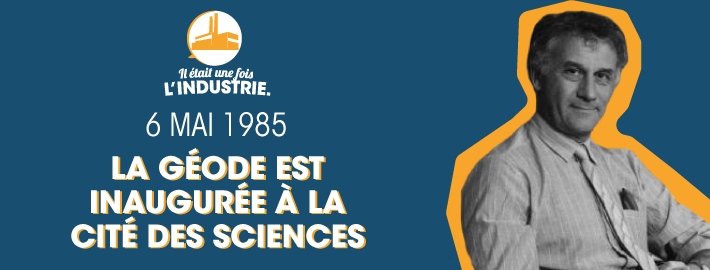GLOBAL
INDUSTRIE
News
Share on

6 May 1985: the Géode is opened at the Cité des Sciences et de l'Industrie
What happened this week in the History of Industry? It is to answer this question that Global Industrie invites you to rediscover, every week, a historical event which occurred around this time… in another age. Today, let’s go back 36 years to the opening of a monument which symbolizes the Paris neighborhood of La Villette… and the world of industry!
A SYMBOL OF THE 80S
The image is a bit faded, but in this INA archive we see President Mitterrand pensively contemplating one of the technical jewels of the mid-eighties which, one year later, was to be attached to the brand new Cité des Sciences et de l'Industrie which was about to be created…
We are in the Parc de la Villette, at the heart of the capital’s 19th arrondissement, facing an impressive "geodesic dome", to use the term coined by its designers, the architects Adrien Fainsilber and Gérard Chamayou. This spherical structure with a diameter of 36 meters consists of lattices which follow its curved outlines, the 2,580 steel tube bars forming a whole series of interwoven triangles distributing tensions on the whole structure, which is self-supporting and thus does not require internal pillars. Its outer surface consists of 6,433 polished steel spherical triangles with 1.20-meter sides which reflect light and are not linked by joints, allowing them to optimize the mirror effect and expand without difficulty according to temperature variations. The water which infiltrates between them in no way damages the overall structure and is collected in the pool which surrounds the building. Below this glass and metal globe lie a set of layers: the main steel framework, heat insulation, sound insulation, waterproofing, etc.
INDUSTRY PUTS ON A SHOW
The film then allows us to follow in the President’s footsteps inside the building, which also houses a film production company. There we discover the 3D cinema, futuristic for the time. This is also a spherical construction, but totally independent from the outer structure: 6,000 tonnes of reinforced concrete supported by a 17-meter central pillar. All of this for the trifling sum of 20 million Euros in today’s currency invested in a symbol of the 1980s and its technological advances, which can be seen in a number of films and music videos from the time, notably in "Vivre ailleurs" by Jakie Quartz, the hard-hitting singer famous for her 1983 hit Mise au Point.
Although it is interesting to note that there are other similar 3D cinemas in France, such as the one at the Futuroscope in Poitiers, the Géode is the only one in the Paris region, following the closure of the Dôme de La Défense in 2001. At the time of its creation, it was managed by a semi-public company independently from the Cité des Sciences et de l'Industrie and had its own employees. This status ended in 2017 when the Pathé group was designated for its takeover. This group then launched a modernization project which is still in progress, the cost of which is estimated at three to six million Euros.
The challenge which awaits it is indeed formidable: made obsolete by new image technologies, its annual number of visitors, which reached a million in its early years, had fallen to less than 300,000 in 2016, and its staff numbers had dropped from around one hundred in the 2000s to around ten at the time of the closing of the cinema for renovations.
OTHER EVENTS WHICH HAPPENED THIS WEEK:
- 3 May (1925): death of the French aviation pioneer Clément Ader
- 4 May (1924): first closed-circuit flight of a helicopter by the French engineer Étienne Œhmichen
- 4 May (1952): a plane lands for the first time at the South Pole
- 6 May (1844): inauguration of the Glaciarium, the first artificial skating rink
- 6 May (1937): explosion of the German airship Hindenburg
- 6 May (1949): EDSAC, the first electronic computer, makes its first calculation
- 6 May (1994): opening of the Channel Tunnel by Queen Elizabeth and François Mitterrand
- 7 May (1895): demonstration of the lightning detector, the first radio receiver, by the Russian physicist Alexander Popov
- 7 May (1915): sinking of the British ocean liner Lusitania
- 7 May (1946): creation of Tokyo Telecommunications Engineering, later to become Sony
- 7 May (1952): publication of the concept of the integrated circuit, the basis of modern computing, by the British electronics engineer Geoffrey Dummer
- 8 May (1971): launching for the first time of eight satellites by a single rocket
- 9 May (1926): the American explorer Richard Byrd flies over the North Pole for the first time
- 9 May (1965): the Soviet probe Luna 5 takes off to go to the moon
2021.05.03